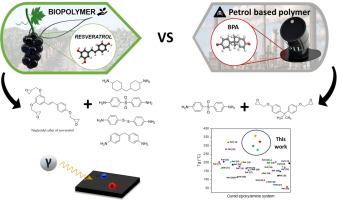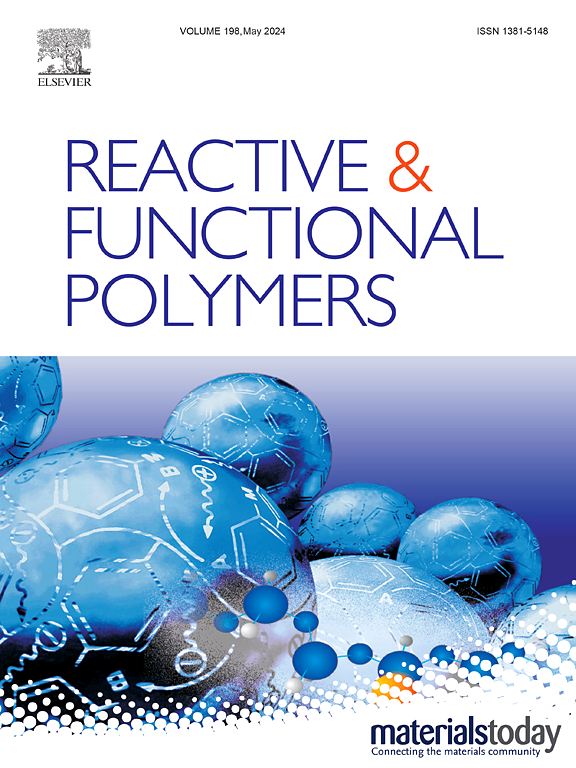Analysis of bio-based epoxy resins: Impact of amine hardeners on thermal, thermomechanical, optical and electrical properties of epoxidized resveratrol with high Tg
IF 4.5
3区 工程技术
Q1 CHEMISTRY, APPLIED
引用次数: 0
Abstract
Epoxidized resveratrol (RES) has been cured with different amines in order to compare their possibilities to obtain high-temperature resistance of bio-based epoxy resins. Materials obtained from the bio-based monomer present glass transition temperatures (Tg) among the highest ever reported for an epoxy-amine curing system, with extremely high char residue, making them excellent candidates for extremely high-temperature applications. Particularly, epoxidized RES stoichiometrically cured with 4,4′-sulfonyldianiline (DDS) reached 297 °C, measured as the tan δ peak by DMTA, and two other materials, using 4,4′-methylenedianiline (DDM) and 4,4′-diaminodicyclohexylmethane (CAA) as curing agents, exceeded 300 °C. In fact, the material begins to degrade before the chains are fully relaxed, so they are thermosetting that never go completely into the rubbery state. Additionally, this resin improves the direct current (DC) insulating character (∼1015 Ωcm) while decreasing the optical band gap (∼2 eV) when compared to other epoxy resins available, which is of great interest for photovoltaic applications. Moreover, some of the materials presented a very high char residue proportion when heated (>40 wt% at 800 °C under nitrogen atmosphere), presenting good fire-retardant properties.

生物基环氧树脂分析:胺类固化剂对高 Tg 环氧化白藜芦醇的热、热机械、光学和电学特性的影响
为了比较不同胺类在获得生物基环氧树脂耐高温性方面的可能性,我们用不同的胺类固化了环氧化白藜芦醇(RES)。从这种生物基单体中获得的材料的玻璃化转变温度(Tg)是迄今所报道的环氧胺固化体系中最高的,而且具有极高的炭残留量,是极高温应用的理想候选材料。特别是用 4,4′-磺酰基二苯胺(DDS)按一定比例固化的环氧化 RES 达到了 297 ℃(用 DMTA 测量的 tan δ 峰值),而用 4,4′-亚甲基二苯胺(DDM)和 4,4′-二氨基二环己基甲烷(CAA)作为固化剂的另外两种材料则超过了 300 ℃。事实上,这种材料在链完全松弛之前就开始降解,因此它们属于热固性,永远不会完全进入橡胶状态。此外,与现有的其他环氧树脂相比,这种树脂提高了直流(DC)绝缘性(∼1015 Ωcm),同时降低了光带隙(∼2 eV),这对光伏应用具有重大意义。此外,其中一些材料在加热时的残炭比例非常高(氮气环境下 800 °C 时为 40 wt%),具有良好的阻燃性能。
本文章由计算机程序翻译,如有差异,请以英文原文为准。
求助全文
约1分钟内获得全文
求助全文
来源期刊

Reactive & Functional Polymers
工程技术-高分子科学
CiteScore
8.90
自引率
5.90%
发文量
259
审稿时长
27 days
期刊介绍:
Reactive & Functional Polymers provides a forum to disseminate original ideas, concepts and developments in the science and technology of polymers with functional groups, which impart specific chemical reactivity or physical, chemical, structural, biological, and pharmacological functionality. The scope covers organic polymers, acting for instance as reagents, catalysts, templates, ion-exchangers, selective sorbents, chelating or antimicrobial agents, drug carriers, sensors, membranes, and hydrogels. This also includes reactive cross-linkable prepolymers and high-performance thermosetting polymers, natural or degradable polymers, conducting polymers, and porous polymers.
Original research articles must contain thorough molecular and material characterization data on synthesis of the above polymers in combination with their applications. Applications include but are not limited to catalysis, water or effluent treatment, separations and recovery, electronics and information storage, energy conversion, encapsulation, or adhesion.
 求助内容:
求助内容: 应助结果提醒方式:
应助结果提醒方式:


